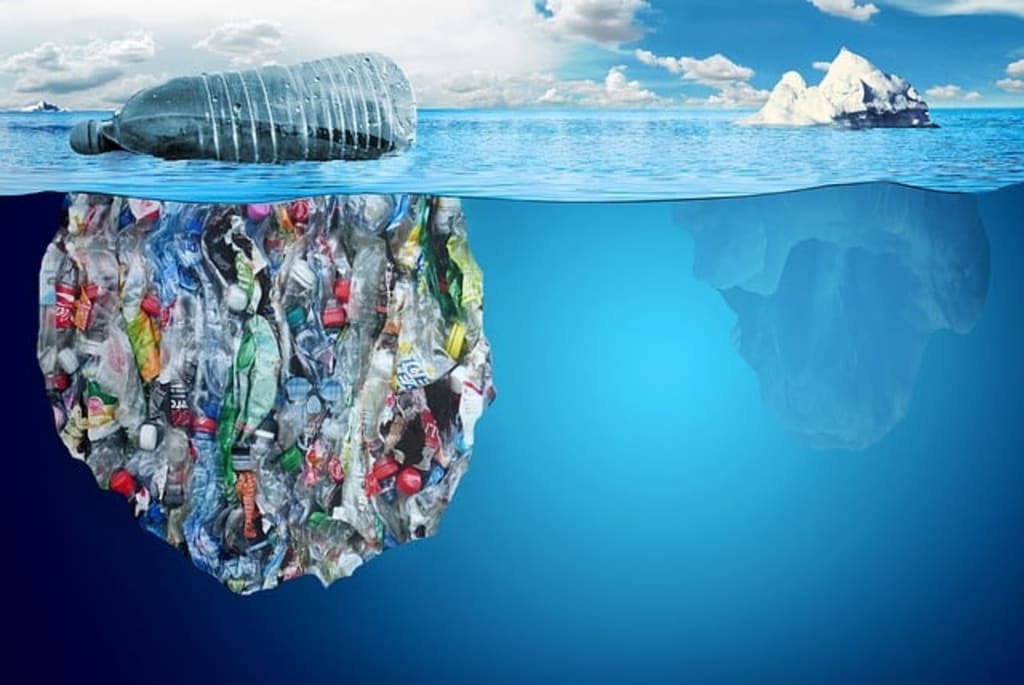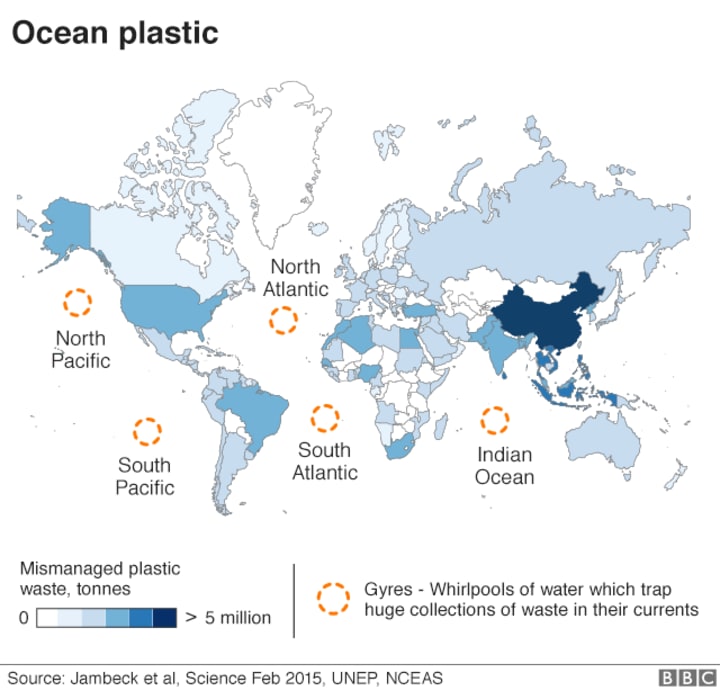Why You Need to Care
Plastic and Its Deadly Effects

If I could, I would sit on this laptop all day and preach to the human race how important it is to care. To care about the resources we use, to care about the effects we have on our planet, to care about the consequences of our convenience mindset actions but I would get nowhere. I would get nowhere because you don’t know why you need to care. You need to care because the amount of plastic we have produced in the first 10 years of the century is already surpassing the amount of plastic humankind made in the last century. In these past 8 years, that number has almost tripled. We are producing and using plastic at an alarming rate, with no regards to how this is affecting our present and our future.
Plastic is all around us, our computers, our televisions, our storage containers, the cups we drink out of and the utensils we use to upkeep our hygiene. To say we should avoid it is absurd. To say we need to be more mindful of its life cycle is sustainable. 50 percent of the plastic we use, we use only once before throwing it away. This 50 percent includes our to-go boxes for food, water bottles, disposable cups, plastic straws, and plastic grocery bags. These plastics products do harm to our own body as well as the environment, the wildlife, and the ecosystems around us.
There are numerous components that go into making the plastic products we use. These harmful chemicals can leak into our food and beverages and cause great harm to our bodies and their functionalities. Bisphenol A, more commonly known as BPA, is found in every single disposable water bottle we purchase by the dozens. BPA leaks into our water and we actually consume it. CDC reported that 93 percent of people have detectable BPA in their urine. This creates a whole monster of a whole new color due to the fact that BPA can actually imitate our bodies' hormones. It interferes with the production, secretion, transportation, action, function, and elimination of natural hormones. BPA can act in a similar way to estrogen especially. Interfering with the hormone production of our bodies can lead us to have reproduction complications and even cause our babies to develop defects while in the womb. People with the highest levels of BPA in their body also were found to have various heart diseases and diabetes. We need to care for the sake of our health and our children’s health.
79 percent of the plastic produced over the last 70 years has been thrown away into the environment and into our landfills. Allowing plastic to sit in the landfill allows the plastic to leak all its harmful chemicals into groundwater, thus poisoning it. Allowing this plastic to be littered across our land will harm our ocean life in the end. We have allowed 8 million tonnes of plastic to leak into our oceans every year. Not total, 8 million tonnes every year. A majority of this plastic waste started on land and was carried to the ocean. This has created 5 vortices of trash in our oceans. Take a look at the following image:

These garbage patches cannot be seen with the naked eye, it cannot be seen by satellite imagery either. These garbage patches are composed of small pieces of broken up plastic. Plastic never actually breaks up and “goes away.” Plastic breaks up into smaller and smaller pieces, causing more and more harm. The largest vortex is just off the coast of California and was named “The Great Pacific Garbage Patch.” It is twice the size of Texas, and the plastic fragments in the vortex outnumber sea life 6 to 1.
All this trash floating in our oceans has caused significant damage to our sea life. Sea turtles will ingest plastic bags due to their poor eye sight because they believe they are jelly fish. Once the bag is ingested, it will either block the opening to the stomach and cause the sea turtle to starve, or it will slowly poison his body with all its harsh chemicals until the turtle passes away due to the overflow of poison in its body. Marine litter harms more than 600 species. People are even referring to this time as the 6th mass extinction of life on earth. By 2050 there will be more plastic than fish. We need to care for the turtles.
It is not only our oceans that are suffering at massive scale, it is also our land, our rocks, our lives, our future. Plastic bags are getting trapped on plants, ultimately killing them. Birds are feeding plastic to their babies, mistaking them for consumables. Mommas, who are trying to nourish their babies and prepare them for their lives, are poisoning them and they have no idea. We are doing this to them. We are tearing down the Amazon rainforest at an ALARMING rate to get resources to continue making our materials. Our Amazon rainforest has an expiration date of 2040. This would put tribes out of homes, animals out of homes, beauty out of our lives. Our children will only know the Amazon Rainforest as a memory and we will have to tell them that this is our fault. We did this. We are altering the course of our future in the worst way possible.
We have entered a new age called Anthropocene. By definition Anthropocene is as follows: relating to or denoting the current geological age, viewed as the period during which human activity has been the dominant influence on climate and the environment. So what does this mean? This means that the 79 percent of plastic that we throw away or litter into the environment is making a lasting impact on our geology. The layer of plastic that is spread across the world will be seen by our future geologists. This plastic is creating a noticeable line in our sedimentary rocks. We are creating a disgusting legacy. The natural history of our rock formation is destroyed and we will be known as the generation who's line in sedimentary rock was plastic. What is this doing to our children? To our grandchildren? What kind of lesson are we teaching future geologists? They will not be able to see fossils, or the components that go into creating geological bands. They will see plastic. They will have to live with our consequences.
There is still time to alter our present and future. 79 percent of our plastic is trashed. 12 percent is incinerated, releasing those chemicals into our air. 9 percent is recycled. With all these people “recycling” their plastic, one would think that number would be higher. In reality, not all plastic is recyclable, and the chasing arrows symbol does not necessarily mean you may recycle the plastic. There are 7 different kinds of plastic. The different types of plastic are as follows:
- - No. 1 : PET (Polyethylene Terephthalate)
- Recyclable, Not reusable
- - No. 2 : HDPE (High-Density Polyethylene)
- Reusable and Recyclable
- - No. 3 : PVC (Polyvinyl Chloride) “Poison Plastic”
- Not reusable or recyclable
- - No. 4 : LDPE (Low-Density Polyethylene)
- Reusable, not always recyclable
- - No. 5 : PP (Polypropylene)
- Reusable, not always recyclable
- - No. 6 : PS (Polystyrene)
- Not reusable, not recyclable, should be avoided in all reality
- - No. 7 : Other (BPA, Polycarbonate and LEXAN)
- All no. 7 plastics have risk for leaking into food and drink
- Not for reuse unless have PLA compostable coding
- Not recyclable
We need to start caring more. We need to care for us, for our ecosystem, for our oceans, for our future. This is not a change that will happen overnight. Since we were young we have been conditioned to just live without taking into consideration where our plastic straws will end up. We throw them away so we are doing our part right? We didn't put it on the ground so it's okay right? It’s not okay? How many times have you been behind a garbage truck on the highway and seen trash spilling over the top and littering the highway? How many times have you seen raccoons rummaging through dumpsters? Where do they take the trash they find? Into the environment, to their babies, to the water. This is a new way of living, a conscious way of living. This is taking responsibility for our actions. Now is the time to be proactive about changing our ways of thinking and stop living for the sake of convenience. Turn off the TV and take time to make a good healthy dinner instead of ordering takeout in the plastic containers. Purchase a stainless steel reusable straw instead of the hundreds you spend every time you get a to go drink with a plastic one and think about where that straw will end up in our environment. Think about the chemicals you are putting in your body when you drink out of a plastic water bottle and get a stainless steel reusable one. Lead a more mindful life, rather than the mindless one you are living. Care more.
About the Creator
Liz Galante
The sunflowers never stop reaching for what they love.






Comments
There are no comments for this story
Be the first to respond and start the conversation.